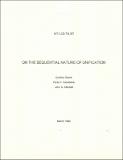On the Sequential Nature of Unification
Author(s)
Dwork, Cynthia; Kanellakis, Paris C.; Mitchell, John C.
DownloadMIT-LCS-TM-257.pdf (4.515Mb)
Metadata
Show full item recordAbstract
The problem of unification of terms is log-space complete for P. In deriving this lower bound no use is made of the potentially concise representation of terms by directed acyclic graphs. In addition, the problem remains complete even if infinite substitutions are allowed. A consequence of this result is that parallelism cannot significantly improve on the best sequential solutions for unification. The "dual" problem of computing the congruence closure of an equivalence relation is also log-space complete for P. However, we show that for the problem of term matching, an important subcase of unification, there is a good parallel algorithm using O(log^2 n) time and n^O(1) processors on a PRAM. For the O(log^2 n) parallel time upper bound we assume that the terms are presented by directed acyclic graphs; if the longer string representation is used we obtain an O(log n) parallel time bound.
Date issued
1984-03Series/Report no.
MIT-LCS-TM-257